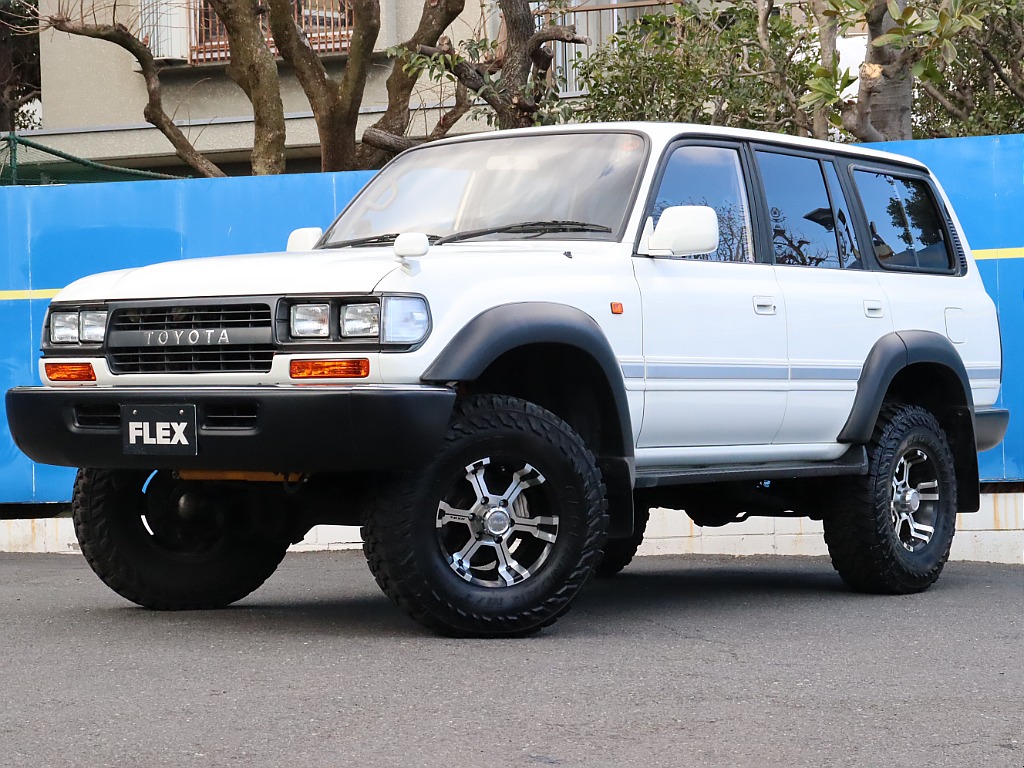What year is the Land Cruiser 80 Series?
Toyota manufactured the Land Cruiser 80 Series between 1990 and 1997. The last of the 80 Series was in December of 1997 when it gave way to the Land Cruiser 100 Series.
80 Series Timeline
The Land Cruiser 80 Series was designed to compete in the luxury SUV market that was dominating the global automotive industry at the time. Toyota focused more on the passenger ride and less on the off-roading capabilities that had once given the Land Cruiser its name.
Once Toyota replaced the leaf springs with coils, the ride smoothed out and body size adjustments offered more passenger room. Toyota lowered the position of the second row seating to the rear of the vehicle while keeping the cargo space and leaving room for the new third-row seat.
The wheelbase was increased from 108 inches in the LC60 to 112 inches in the new LC80. Even though the body and wheelbase were longer, the turning radius was reduced because the front suspension change made the wheelhouse cleaner.
The Land Cruiser 80 Series body had smoother, rounder lines for an appealing softer look found in competitors.
Luxury SUV buyers took notice.
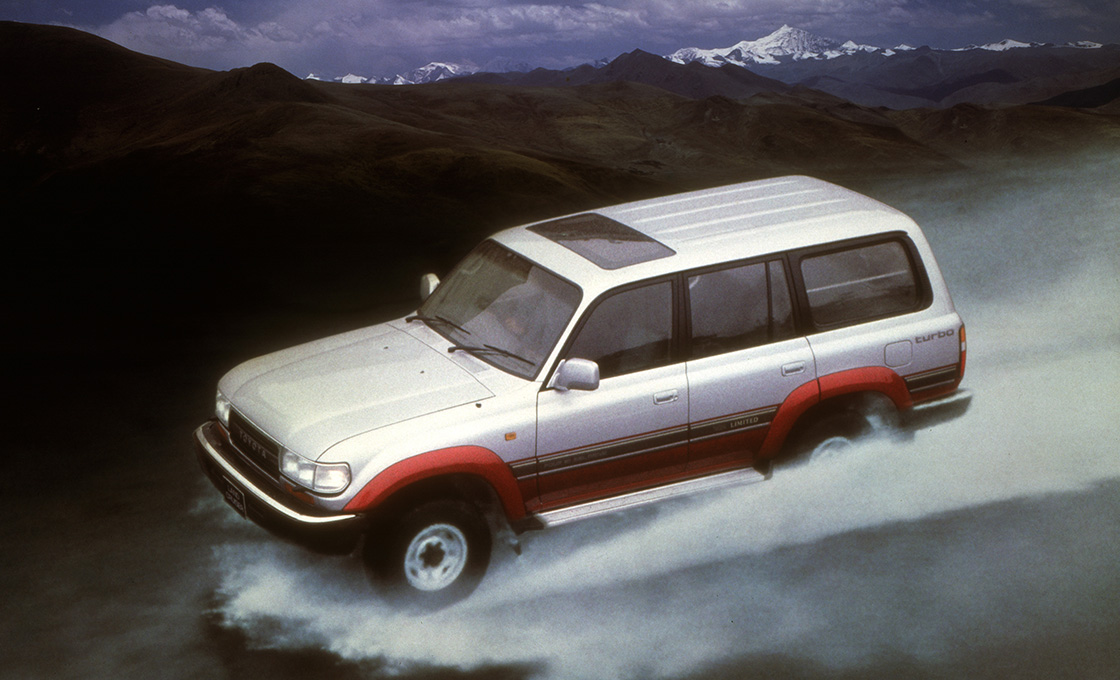
1990
As soon as people heard about the changes in the LC80, die-hard off-road fans scrambled to buy the last of the LC60s. That slowed production down and delayed the release of the Land Cruiser 80 Series from December 1989 until January 1990.
The 1991 model included a 3-point rear seatbelt, standard AC, and intermittent windshield wipers. In addition, a 4-speaker audio system was offered on some trim levels.
The 1991 model was the first Land Cruiser 80 Series to be imported into the United States.
1992
There were only minor changes in the Land Cruiser 80 Series in the 1992 model.
In 1993, Toyota introduced a new color option, and the AC system went from a refrigerant gas to a more environmentally friendly product.
The original 4.0L 3F-E gas-powered engine was swapped out for the newly developed 4.5L 1FZ-FE engine. The straight-6 went unchanged, but a 24-valve DOHC greatly improved the power performance. The AT is electronically controlled that results in improved fuel efficiency. Toyota stiffened up the suspension and lowered the vehicle’s height.
1995
At this point, the Land Cruiser 80 Series is now considered a late model. It was given slight modifications that included a change to the front grille and a modified mark from “TOYOTA” to an oval “T” mark.
Another new body color was added, and in the interior, the instrument panel layout was changed to a straight line. At the same time, the fabric and seat design was also improved. An optional driver airbag was offered.
By August 1996, all models were equipped with front seat airbags, and 4WD ABS was a standard safety upgrade.
The Land Cruiser 80 Series has undergone two major-minor updates in its eight years of production with a minor change in between. Between the emissions standards changes and the safety improvements, many of the earlier models are no longer available, but there are still gas- and diesel-powered LC80s with updated safety features on the market.
80 Series Specs
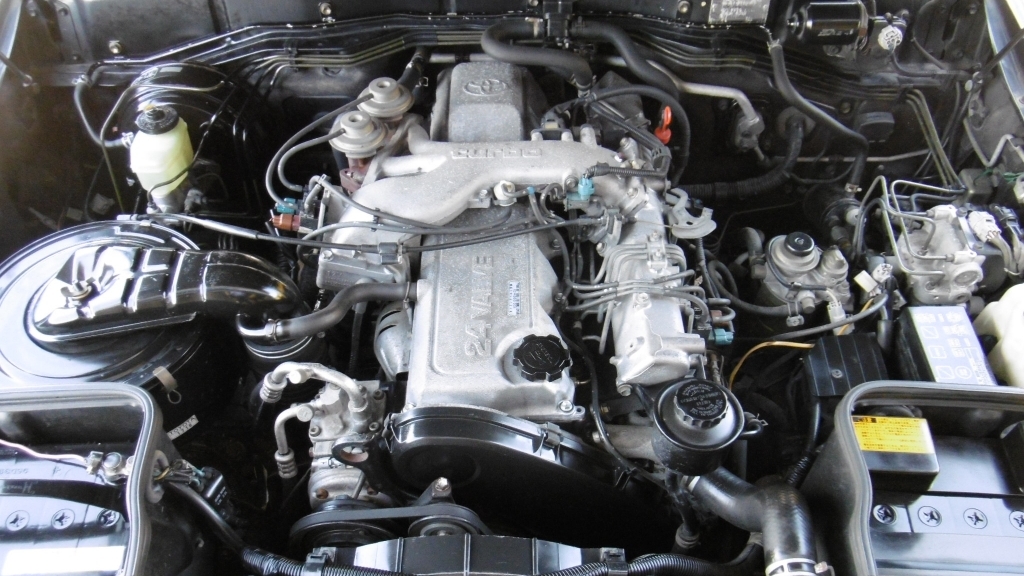
The Land Cruiser 80 Series was available in three trim levels and four engine choices except in the North American market. In North America, only one model was sold with a gas-powered engine.
Trim Levels:
| STD | base commercial van model |
|---|---|
| GX | mid-level model |
| VX | van/wagon models – includes VX Limited |
| FJ80 | North American model 1990-1992* |
| FZJ-80 | North American model 1993-1997* |
Engine Choices:
| 4.0L 3F-E | gas-powered inline-6 (until replaced by the 4.5L 1FZ-FE in 1993)* |
|---|---|
| 4.5L 1FZ-FE | gas-powered inline-6 (1993 and up) * |
| 4.5 1FZ-F | carburetor gas-powered inline-6 (1993 and up)* |
| 1HZ | diesel non-turbo 4.2L inline-6 |
| 1HD-T | diesel turbo direct injection 12-Valve SOHC |
| 1HD-FT | diesel turbo direct injection (improved 1HD-T) |
Transmission Choices:
- 4-speed manual
- 4-speed A440F automatic
- 4-speed A442F automatic
- 4-speed A343F automatic
- 5-speed H150F manual
- 5-speed H151F manual
The following Land Cruiser 80 Series specs are based only on the *North American versions.
Specs: 1990 80 Series
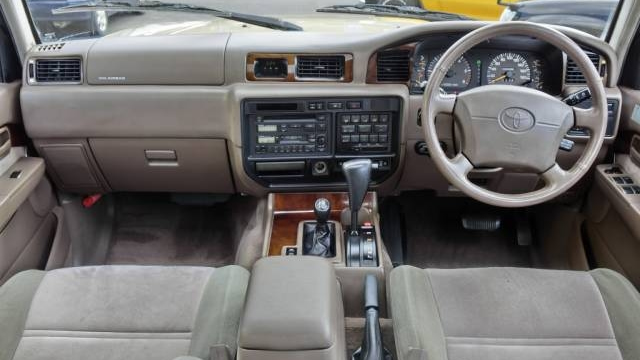
| Model | FJ80 |
|---|---|
| Engine | 3F-E – 4.0L inline-6 |
| 4WD | Full-time |
| Wheelbase | 112.2 inches |
| Length | 188.2 inches |
| Width | 74.0 inches |
| Height | 74.4 inches |
| Curb weight | 4,594 pounds – approximately depending upon the transmission |
| Horsepower | 155 @ 4,200 RPM |
| Torque | 213 lb.-ft. @ 2,600 RPM |
| MPG | 11 |
Equipment:
- Open center differential (auto lock in 4LO and lockable in 4HI)
- 15-inch wheels
- Coil springs
Specs: 1992 80 Series
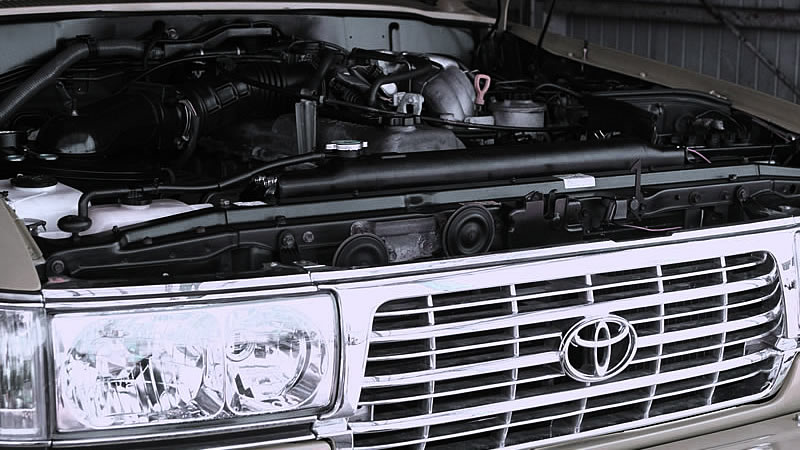
| Model | FJ80 |
|---|---|
| Engine | 3F-E – 4.0L inline-6 |
| 4WD | Full-time |
| Wheelbase | 112.2 inches |
| Length | 188.2 inches |
| Width | 42.0 inches |
| Height | 73.4 inches |
| Curb weight | 4,594 pounds – approximately depending upon the transmission |
| Horsepower | 155 @ 4,200 RPM |
| Torque | 213 lb.-ft. @ 2,600 RPM |
| MPG | 11 |
Equipment:
- Third-row seat
- Overdrive
- Auxiliary mirror on the passenger fender
- Minor changes to button colors and shift knob design
- LED high-mount stop lamp
Specs: 1995 80 Series
| Model | FZJ80 |
|---|---|
| Engine | 1FZ-FE inline-6 24 valve |
| 4WD | Full-time |
| Wheelbase | 112.2 inches |
| Length | 189.8inches |
| Width | 76.0 inches |
| Height | 74.4 inches |
| Curb weight | 4,760 pounds – approximately depending upon the transmission |
| Horsepower | 215 @ 4,600 RPM |
| Torque | 275 lb.-ft. @ 3,200 RPM |
| MPG | 12-15 |
Engine option:
| Engine | 1FZ-F inline-6 24-valve carburetor |
|---|---|
| Horsepower | 190 |
| Torque | 267.74 lb.-ft. |
Equipment:
- Airbags on driver and passenger sides
- 16-inch wheels
- ABS
- Shoulder belts
- Updated Toyota badge
- Upgraded fabrics in seats and carpet
- Panel ceiling
- Minor changes to the instrument panel, assist grip, sunroof glass, wheels, and ECM
40th Anniversary Specifications
The 1997 40th Anniversary model was limited to two colors: Antique Sage Pearl and Emerald Green. 4,744 units were sold in the United States. The badges and trim all had the 40th Anniversary Limited Edition emblem on them, and the floor mats were embroidered with it.
It was equipped with automatic climate control, brown and tan leather interiors, and dark grey trimmed wheels. Toyota offered optional electric front and rear locking differentials, roof racks, running boards, and keyless entry in some models. It was also the last year for the electric locking front differentials.
The Differences from Lexus LX450
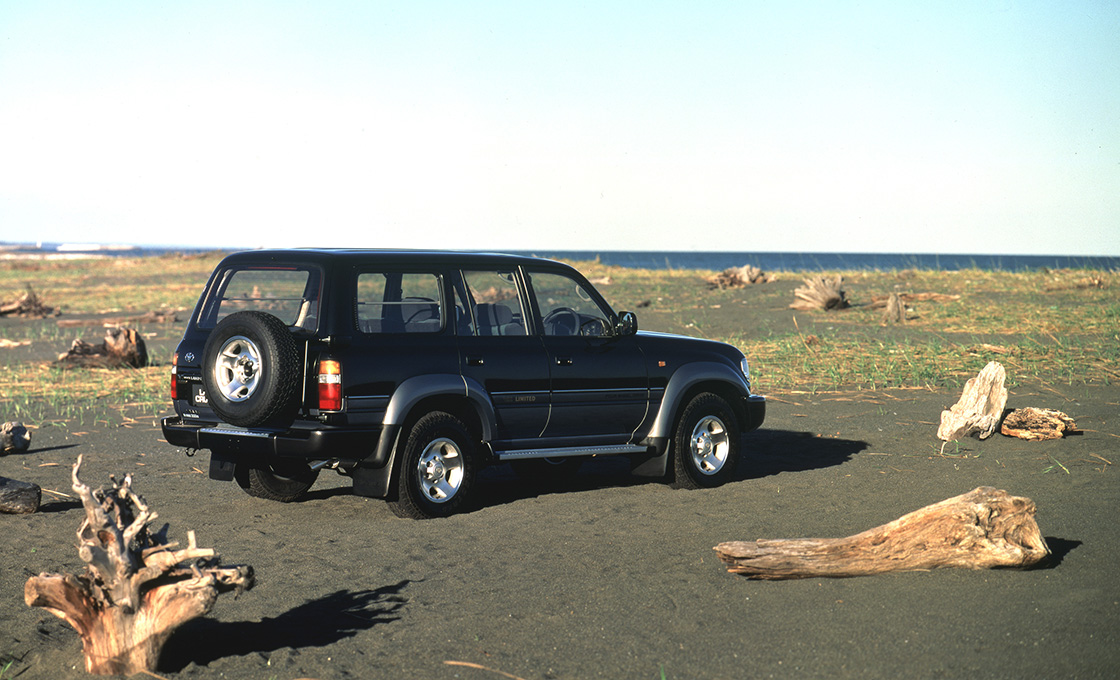
The first Lexus LX 450 wasn’t introduced until 1995 when rumors of a trade war from the United States against some Toyota and Lexus luxury car models were swirling around. Since there were no SUVs on the proposed list, Lexus put a badge on the Land Cruiser 80 Series and called it an LX 450.
It was powered by the same 4.5L 1FX-FE inline-6 that was found in the 1995 LC80 models, but it had some differences that included the following:
- Better leather and richer interior feel
- “Woodgrain” paneling
- An upgraded stereo system that included a 6CD changer
- Softer suspension for a smoother ride
- Upgraded wheels
- Side running boards
- Better sound insulation
- Upgraded electronics like a phone system and remote key
- Lexus grille
- Longer warranty
- Much higher price
While the trade war never materialized, the Lexus LX 450 went on to become a success in the American marketplace. The second generation LX 450 began in 1998 and mimicked the Land Cruiser 100 Series models.
Are 80 Series Landcruisers reliable?
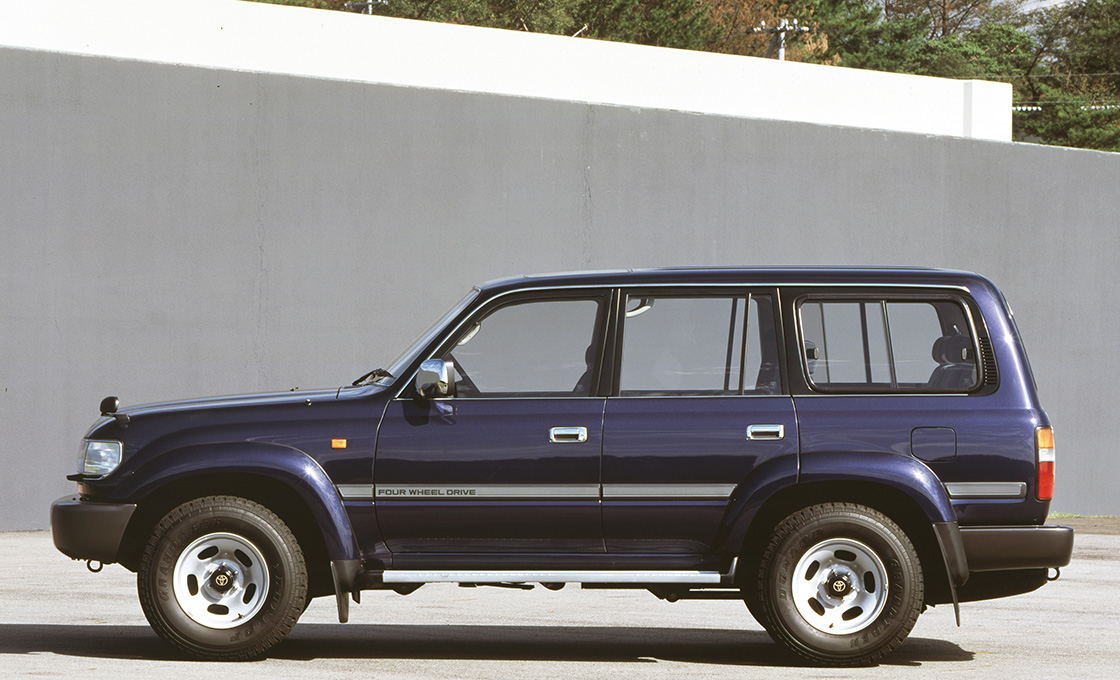
When it comes to reliability, the Toyota name is at the top, and the Land Cruiser 80 Series is no different than any other Toyota. While it always comes down to best maintenance practices, even a neglected Land Cruiser can still go over 100,000 miles; there are documented instances of Toyota Land Cruiser 80 Series having more than 300,000 miles on the odometer.
How many 80s Series Landcruisers were made?
By the time the last 80s Series Landcruisers rolled off the assembly line in 1997, Toyota had produced 547,400 total units worldwide and over 74,000 units were sent to the dealers in North America according to the Customer Relations folks at Toyota USA. By 1999, over 3.5 million total Land Cruisers had been sold, and in 2019, those sales surpassed 10 million units in 170 countries and regions.
What is an 80 Series Land Cruiser worth?
The worth of a Land Cruiser 80 Series can vary depending on the model and any modifications that may have been done to it over its lifespan. The average price for a Land Cruiser 80 Series is approximately $27,500.
On the low end, you can find some models from 1990 in the $3,000 range, and on the upper end, there are some 1997 models with an upper price of $34,980. Again, it all is determined by the usual factors like the year, mileage, equipment, extras, and overall condition of the LC80 you’re looking at.
Simplicity at its Finest
Staying true to the Land Cruiser’s purpose, Toyota designed the Land Cruiser 80 Series to be simple like its predecessors. While it may be less of a workhorse and more of a luxury SUV, it still was designed with simplicity in mind. The interior is clean, and the layout is simple.
It was also a time of tremendous changes in technology, so many of the upgrades brought the Land Cruiser current with safety, entertainment, and performance innovations.
Still, the simplest and most retro-feeling Land Cruiser 80 Series is the STD, GX, and VX models, but they are difficult to find on the market.
Full-Time Four-Wheel Drive
This is the first full-time 4WD Land Cruiser, which makes it convenient for both on and off-road driving. The new system delivers more force towards the front wheels. Some of the traditional components were revamped like the freewheel hub that cuts off the electric switch.
Are 80 Series Land Cruisers Relatively Cheap?
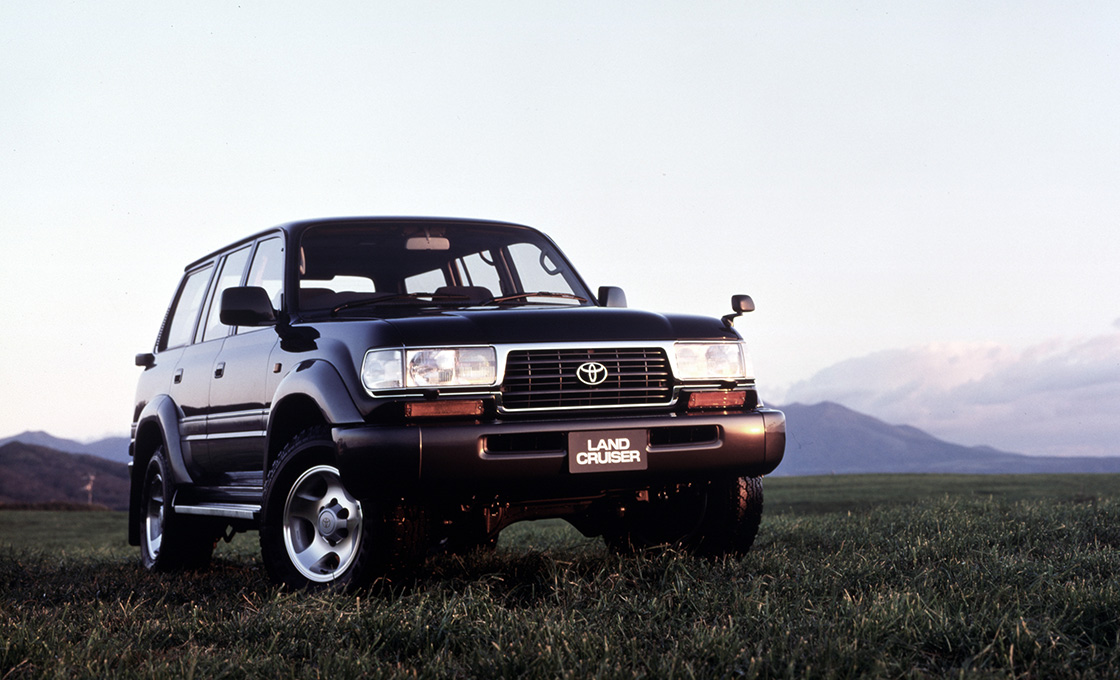
Depending upon the equipment, it is possible to find a used Land Cruiser 80 Series relatively cheap when compared to the cost of an LC100. Since it is a Land Cruiser, it is considered a durable 4WD that holds its value as long as it’s maintained. There are plenty of maintenance parts still available for the LC80 models, so taking care of it should be easy.
When shopping for a used LC80, take into consideration the year and the standard safety features like the three-point seatbelts, airbags, and 4WD ABS. If you find an older model with safety features, they could have been optional equipment added at the time of purchase.
The market prices for the used LC80s range from $5,781 to $13,000 for early models, $5,781 to $16,000 for the mid to late models, and $5,781 to $18,000 for the late models. The minimum prices are almost constant since there is little difference between the mid and late-term models. The price rise can be attributed to the amount of customized used cars that are on the market. Very few Land Cruiser 80 Series are in their original condition.
The most popular used Land Cruiser 80 Series on the Japanese market is the fully equipped VX Limited powered by the 4.5L gas engine. It offers great fuel mileage and the luxury of a passenger SUV. Since it was a best-seller, you can find a wide variety of these on the market equipped to meet your needs.
Land Cruiser 80 series Pros and Cons
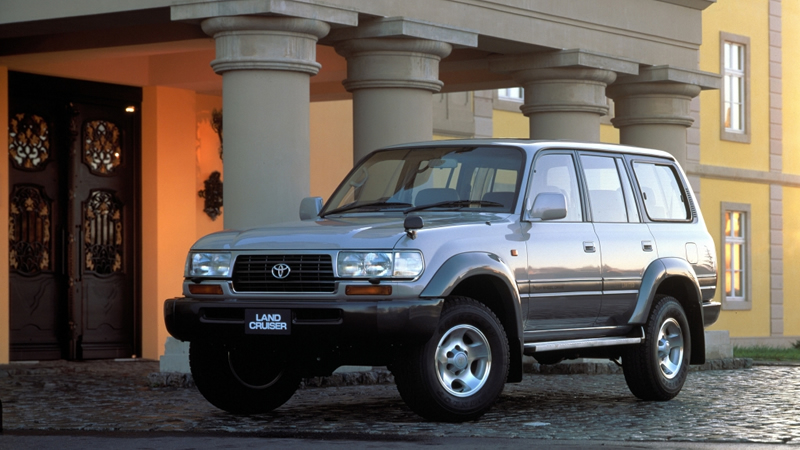
Based on user reviews and fan clubs, the Land Cruiser 80 Series is the best of the best, but like all things, there are pros and cons about the vehicle. Here are some good and bad things that we found when we evaluated all of the Land Cruiser 80 Series models:
Pros
- The extended wheelbase made the cabin roomier
- The sharp turning radius makes it easy to turn on city streets
- Coil springs gave it a passenger car ride
- The quiet 4.5L inline-6 1FZ-FE has abundant low-speed torque for a smooth start
- The 1HD-T/1HD-FT does have reasonable low-speed torque and appealing increased revs
- The 1HD-T/1HD-FT is even smoother on the start than the 1FZ-FE
- Suspension settings are slightly harder on the mid/late models for better stability
- The early models have a larger stroke and are better suited for cross-country off-road driving
- Later models are more suitable for off-road and high-speed driving in the dirt
- The full-time 4WD is more stable during general driving and doesn’t spin easily
- The center differential lock is located by the driver’s seat for easy access
- The 4WD system is perfect for beginners and veteran drivers
Cons
- The 1FZ-FE does not have the torque it needs to accelerate quickly, losing fuel efficiency
- The 1HD-T / 1HD-FT does not have the response you’d expect from a turbo
- The part-time 2WD is less stable when driving on the road
Conclusion
Regardless of the year and model, the Land Cruiser 80 Series dominates the used SUV scene and is adding new fans to the Land Cruiser name daily.





